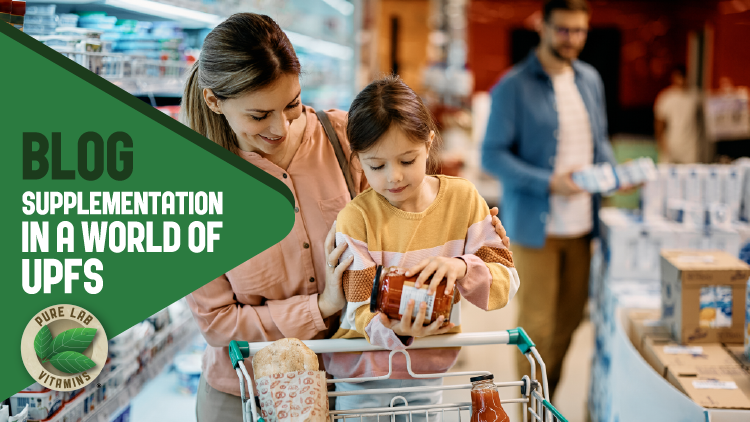
 |
By Andrea Bartels CNP NNCP RNT 21 Sep 2023 |
Ultra-processed foods (UPFs): they’re designed to deliver deliciousness at the lowest production cost possible. Frozen dinners, desserts, yogurts, instant soups, candy, cereals, crackers, soft drinks and even protein bars -- these are just a few of the thousands of UPFs whose presence dominates most of today’s supermarkets.
Virtually everyone has eaten UPFs. Even infant formula is a UPF—but with an important difference. Unlike most UPFs, the government requires that baby formula be fortified with essential vitamins and minerals because it is typically a non-breast-fed infant’s sole source of nutrition. But to compare, the vast majority of UPFs are not nutritionally fortified—leaving us nutritionally starved for vitamins and minerals when our diets are based on these foods.
As a society, we are generally overfed and undernourished. Since UPFs are generally easy to eat, more calories are consumed per minute than with whole foods. It’s easy to overeat them because they’re usually formulated to be ‘hyper-palatable’—that is, to taste great—and this induces over-indulgence. There are 2 major concerns about this. For one, the more processed a food becomes, the less complete nutrition it contains. Second, the more calories we consume, the more vitamins and minerals we need to support the body’s metabolism of UPFs.
Aren’t most foods subject to some sort of processing? Absolutely. Most foods are at least minimally processed. Lettuce in ready-to-eat salad boxes has been ‘triple washed’. Whole oats are sliced into flakes to reduce cooking time. Canned chickpeas are cooked in the can, with some added salt. But the redeeming feature that these foods have in common is that nothing here has been stripped away. These are still whole foods, with most of their original naturally-occurring vitamins and minerals remaining intact.
How are UPFs different? To compare, the NOVA food classification system describes UPFs as “formulations of low-cost substances derived from unprocessed or minimally processed foods with little to no whole foods…(they) always contain edible substances not used in home kitchens (e.g. protein isolates) and /or cosmetic additives (e.g., flavors, colours, emulsifiers). Processing involves multiple steps and industries and aims to create products liable to replace all other NOVA (food) groups.” I find it disturbing that these substances have undergone so many processing steps that their food or origin can no longer be identified by sight, or even taste. For example, among the over 20 ingredients found in the average frozen pizza, there can be a lot of mysterious-sounding ones: dough ‘conditioners’, flour, ‘modified food starch’, vegetable oils, gums, lecithin, etc. Even as a nutritionist I cannot decipher from this list what foods these originate from. I suspect it would be hard to tell the difference between some of these ingredients, let alone identify their source by just looking at them. That’s what ultra-processing can do: make food unidentifiable. I don’t feel good about that. Do you?
A diet lacking fresh, whole foods runs the risk of being deficient in vitamin C and B vitamins, which could produce symptoms rather quickly. For instance, vitamin C deficiency causes bleeding gums, easy bruising, and poor resistance to infection. The B complex family of 9 different vitamins work together intricately to ensure the body’s metabolism is not disturbed, with each nutrient serving unique roles that must be fulfilled to prevent B-deficiency related health problems from occurring. Since the body has no way to store these water-soluble nutrients, once ingested they quickly get absorbed, used up or discarded into the urine. Supplementing vitamin C and biologically active B vitamins daily in a slow-release format can help ensure you achieve more consistent blood levels of these essential nutrients on a daily basis.
Minerals are another set of essential nutrients lacking in UPFs for 2 reasons. Ingredients used in UPFs are typically sourced from crops that are grown in mineral-deficient soils, and secondly, existing minerals are easily lost through umpteen processing steps. Once digested, these mineral-deficient UPFs are acid-forming, meaning they contribute to an increased acid load. If the diet cannot supply enough minerals, the body must give up its mineral stores to do this. While the short-term effects of excess acidity in the body are associated with sensations of fatigue and stiffness, long-term effects can manifest as inflammatory degenerative diseases, like gout, arthritis and osteoporosis, to name a few.
Pure Lab’s Alkapure pH provides the alkaline minerals sodium, potassium, and magnesium in forms that the body uses to buffer acids. To initiate pH balance, 3 capsules of Alkapure pH are taken twice daily on an empty stomach. This can be reduced to 2 capsules twice daily as maintenance.
UPFs are everywhere, making them difficult to avoid completely. While they’re certainly a convenient and often tasty way to get calories in a hectic lifestyle, time will tell their effects on our health. In the meantime, supplementing some of the key vitamins and minerals lacking in UPFs is a smart thing to do.
References
Canadian Food Inspection Agency. “Foods to which vitamins, mineral nutrients and amino acids may or must be added [D.03.002, FDR].” Accessed online September 11, 2023.
Dixon, Rachel. “Ultra-processed foods: the 19 things everyone needs to know.” The Guardian Wed. 6 Sept 2023.
Global Food Research Program. Ultra-processed foods: A global threat to public health. Univerity of North Carolina at Chapel Hill. Accessed online Sept 7, 2023.
Green J, Kleeman CR. Role of bone in regulation of systemic acid-base balance. Kidney Int. 1991; 39: 9-26.
Heinz, David. “Symptoms of Vitamin B Deficiencies.” Healthline. June 25, 2023.
Office of Dietary Supplements. “Vitamin C: Fact Sheet for Consumers”. National Institutes of Health.
Remer T, Manz F. Potential renal acid load of foods and its influence on urine pH. J Am Diet Assoc. 1995; 95(7):791-797.
Schatzker, Mark. The Dorito Effect: The Surprising New Truth about Food and Flavor. Simon and Shuster, 2016.
Van Tulleken, Chris. Ultra-Processed People: Why we can’t stop eating food that isn’t food. Knopf Canada, 2023.
 WHAT'S HAPPENING AT PLV
WHAT'S HAPPENING AT PLV 